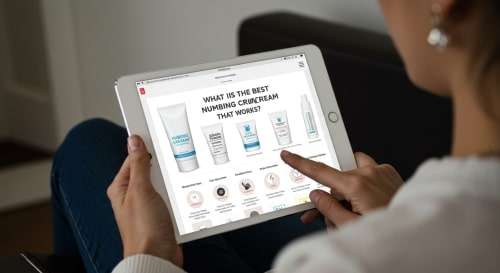


Have you ever wished there was some way to switch off the pain before getting tattoos, waxing, or undergoing any medical procedures? In other words, so is the promise that numbing creams deliver. However, with so many creams promising the best relief, we are unsure which ones work.
Topical anesthetics or numbing media are creams, sprays, or gels used on your skin that will numb a specific area for a while. They stop the route that pain signals typically take from your skin to your brain. It’s like dimming the signal to your brain that you are in pain for a while.
Overall, numbing creams make your pain messengers take a rest for some time. The cream numbs your nerves so your brain doesn’t receive pain messages.
Most numbing creams contain a compound that temporarily blocks nerve signals. Main ingredients include:
▶ Lidocaine
▶ Benzocaine
▶ Tetracaine
▶ Prilocaine
As each ingredient works somewhat differently, they all share the same goal of blocking nerves from transmitting pain signals to your brain. It’ll essentially make your skin unable to feel pain for a while.
A wide range of people resort to numbing creams for such purposes as:
▶ Before getting tattoos
▶ Before waxing or laser treatment for hair removal procedures.
▶ Before injections or blood draws
▶ For skin treatments like micro-needling
▶ Before piercings
▶ To soothe hemorrhoid pain
▶ For chronic pain conditions
Not all needs or scenarios will have a single best numbing cream. Here's what matters:
We will look at several popular suggestions that users and experts highly recommend.
When preparing for medical procedures like tattooing, look for the most powerful over-the-counter numbing cream. Users and professionals often recommend the most effective over-the-counter treatments, the ones with 5 % lidocaine.
Tattoo artists often advise the use of products from the TKTX brand. The cream contains a mixture of elements meant to deliver more effective numbing. The downside? It may sometimes be hard to find it in reliable stores.
A second good choice, if readily available, is to use creams that contain lidocaine at a rate of 5% and epinephrine; this keeps the lidocaine active for a more extended period because it closes blood vessels and holds it in place. Putting on these creams 30-60 minutes before your procedure and then covering them with plastic wrap ensures they function as they should.
A 4% lidocaine cream usually works for milder treatments such as waxing or laser sessions. These products are typically available in drugstores and online.
Among them are Ebelane and Aspercreme, which contain 4% lidocaine and become effective after approximately 20 – 30 minutes of usage. They are easier to use than stronger creams because they do not require a plastic wrap and absorb quickly.
For people with sensitive skin, choose numbing creams without alcohol, fragrances, or preservatives that may irritate. There are also creams labelled hypoallergenic to prevent skin irritation.
However, if you have sensitive skin, it is always advisable to test any new product on a small part of it.
Always confirm with the doctor if you prefer to use products for kids. Select children’s products after clearance from a healthcare provider, since they may contain fewer active ingredients.
Benzocaine is a popular ingredient in children’s creams. Still, both benzocaine and lidocaine should be used carefully and sparingly on little ones.
A top-notch numbing cream is effective only if it is applied well. Here are some tips:
First, cleanse the skin to avoid interference with absorption by oils and dirt.
Use more than you think is needed (a lack of sufficient application is common).
You should wait. Most numbing creams take 15 to 60 minutes to reach optimum standards.
Underlining the cream with a damp cloth or plastic wrap might strengthen the numbing effect.
You shouldn’t expect immediate complete pain relief. Numbing creams are used to reduce pain, but not eliminate it.
Numbing creams have limitations. Consider these potential drawbacks:
▶ Specific individuals might face skin irritation or an allergic response to numbing creams.
▶ Overuse may be risky, particularly when used on larger body areas.
▶ Once the cream is applied, you will only numb for 1-2 hours.
▶ Stronger options can be pricey
▶ If your numbing cream is not wiped off before your tattoo, it can blend with the ink, causing decolorization.
Numbing creams are generally safe for most people, but not right for everyone. Skip them if:
▶ You are allergic to any ingredients
▶ Medical conditions may mean avoiding them (ensure you consult with your doctor before using them).
▶ You will be using them in a wide area.
▶ You intend to consume them (usually, they are not designed for internal consumption)
▶ If pregnant or breastfeeding, consult your doctor first.
For severe numbing needed during practices like tattoos, 5 % lidocaine cream, which has received positive feedback from tattoo experts, is the best. Apply it generously before the practice and make sure that you cover the affected body part.
Suppose you’re only contending with minor problems such as waxing or a mild sunburn. In that case, over-the-counter 4% lidocaine cream works great for light cases. To quickly relieve bug bites or minor scrapes, 4% lidocaine sprays or roll-ons are ideal for on-the-go relief, even though they don’t numb as strongly as better formulas.
One needs to understand that people differ in their sensibilities. The product that does an excellent job for somebody might also not suit you. Usually, several alternatives should be tried before a custom-made product can be found.